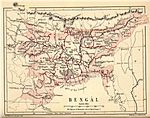Vaṅga | |||||||||||
|---|---|---|---|---|---|---|---|---|---|---|---|
| c. 1100 BCE–c. 340 BCE | |||||||||||
 Vanga and other kingdoms in Late Vedic Period c. 1100 BCE | |||||||||||
 Vanga and erstwhile neighbors in ancient India | |||||||||||
| Capital | Probably Chandraketugarh (in present-day Berachampa) | ||||||||||
| Common languages | Vedic Sanskrit | ||||||||||
| Religion | Historical Vedic Religion | ||||||||||
| Government | Monarchy | ||||||||||
| Raja (King) | |||||||||||
• c. 10th century BCE | Samudrasena | ||||||||||
• c. 9th century BCE | Chadrasena | ||||||||||
| Historical era | Iron Age | ||||||||||
• Established | c. 1100 BCE | ||||||||||
• Disestablished | c. 340 BCE | ||||||||||
| |||||||||||
| Today part of | Bangladesh India | ||||||||||
| History of Bengal |
|---|
 |
Vaṅga was an ancient kingdom and geopolitical division within the Ganges delta in the Indian subcontinent.[1] The kingdom is one of the namesakes of the Bengal region.[2] It was located in southern Bengal. Vanga features prominently in the epics and tales of ancient India as well as in the history of Sri Lanka.
Vanga was probably the center of the Gangaridai Empire mentioned by numerous Greco-Roman writers. The exact capital of ancient Vanga kingdom could not be identified. After the rule of the Gupta Empire, ancient Bengal was divided into two independent kingdoms – Gauda and Vanga. Historically, Chandraketugarh, present-day Berachampa, has been identified as the capital of the Vanga kingdom.[3]
Indian and Greco-Roman writers referred to the region's war elephants. In Indian history, Vanga is notable for its strong navy. There are numerous references to Vanga in the Hindu epic Mahabharata, which is one of the two major Sanskrit epics of India. The other epic, the Ramayana, mentions the kingdom as an ally of Ayodhya.
- ^ "The Rise of Islam and the Bengal Frontier, 1204–1760". publishing.cdlib.org. Retrieved 14 June 2021.
- ^ "West Bengal | History, Culture, Map, Capital, & Population". 11 February 2024.
- ^ Banerjee, Samayita (2018). "Chandraketugarh: Neglected Heritage of Bengal". Sahapedia. Retrieved 25 June 2024.
Chandraketugarh remains one of the most important early historic urban coastal sites of eastern India. Though seemingly insignificant, it is far from being such in the works of geographer Ptolemy and the Periplus of the Erythrean Sea, two of the most important early non-Indic sources frequently used in historical research, who identify it as the ancient capital of Vanga and possibly of the kingdom of Gangaridae.